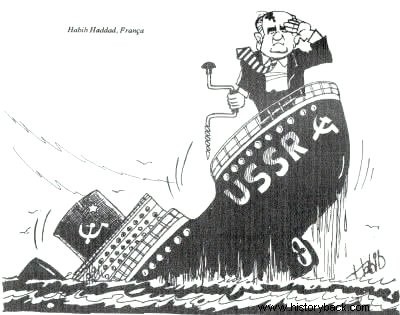Perestroika and Glasnost were the reformist policies carried out by the General Secretary of the Communist Party of the USSR, Mikhail Gorbachev, from 1985-1991.
 Shop out of stock in Russia in 1991.
Shop out of stock in Russia in 1991.
Perestroika
Perestroika or “restructuring” consisted in ending the economic centralization established by Lenin after the Russian Revolution in 1917.
The Soviet economy was planned by the state, there was no private property and the prices of industrialized and agricultural products were set by the government.
In this way, there was no competition and if the people didn't go hungry, there was no variety or abundance either.
Likewise, most of the investments went to the heavy weapons industry and the war against Afghanistan.
Read about the War in Afghanistan.
Gorbachev, little by little, opens up the Soviet market with the following measures:
- reduction of subsidies to the economy
- end of state economic planning,
- liberalization of foreign trade,
- elimination of product manufacturing limits,
- authorization to import foreign products,
- Arms manufacturing reduction.
Perestroika failed to open up the Russian economy for several reasons.
The first was the resistance of liberal and communist politicians to accepting these measures. Second, Russian industry lagged far behind the West and suddenly found itself without subsidies.
Finally, with the disorganization of the countryside, food shortages followed, causing revolt in the population.
Glasnost
Glasnost or "transparency" was the policy that aimed to bring the population closer to the political decisions of the Soviet Union. It also sought to combat corruption among Communist Party members.
These measures contributed to the end of the Soviet Union, as the people had space to discuss the changes that were being made at that time.
So we can cite the main measures of Glasnost:
- amnesty for political prisoners,
- official end of the Gulag,
- end of censorship of newspapers and artists,
- freedom for religious groups
- end of one-party system
- rehabilitation of victims of Stalin's rule.

Consequences of Perestroika and Glasnost
In 1988, while addressing the UN, Gorbachev declared that all nations should be free to choose their destiny without outside interference. These words had an unexpected effect on Eastern European countries.
The following year, communist rule peacefully fell in Poland, Hungary, East Germany, Czechoslovakia, and Bulgaria.
Only in Romania was there a confrontation between the army and the population and the execution of President Nicolai Ceausescu and his wife.
At the end of 1989, with the fall of the Berlin Wall, discussions would begin that would result in the reunification of Germany in October 1990.
As for the Soviet Union, it would face the rebellion of several republics that had been annexed such as Estonia, Lithuania and Latvia.
Submitted to a referendum, the Soviets decide to end it in 1991 and Gorbachev resigns from the presidency of the republic at the end of that year.
Learn all about the end of the USSR and the life of Mikhail Gorbachev.
Read more:
- Russia
- Margaret Thatcher
- Ronald Reagan
